- Accueil
- Base de données
- 22
- 11th January, 1943
11th January, 1943
Hawker TYPHOON Mk Ib
R8802 (code ZH-Q)
"La rue Auffray " Plélo (22)
(contribution : Claude Archambault, testimony 23rd May, 2011- Bruno Delmas)
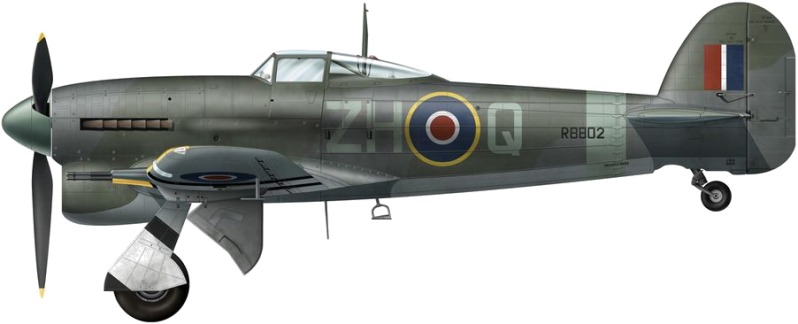
© Jean-Marie Guillou
Pilot :
Flight Lieutenant JAMES CLACK (TOMMY) THOMPSON
266 (Rhodesia) SQN, Royal Air Force
Prisoner Camp n°175 - L3
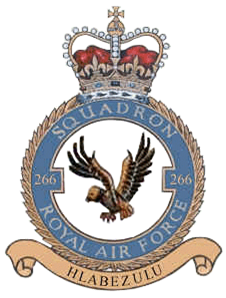
THE STORY
PLÉLO. Côtes d'Armor. Village of the Auffray street. Monday 11th, January 1943.
Late at night on the Warmwell base in Dorset County. South of England. Squadron Leader Charles Green belonging to the Royal Air Force No. 266 (Rhodesia) Squadron RAF received early in the morning the departure order for an attack mission on railroad tracks in the region of Saint-Brieuc in the department of "Côtes du Nord" (former name of current Côte d'Armor). These missions on occasional targets were curiously called '' Rhubarb '', a codename used by all units of the RAF during the 2nd World War.
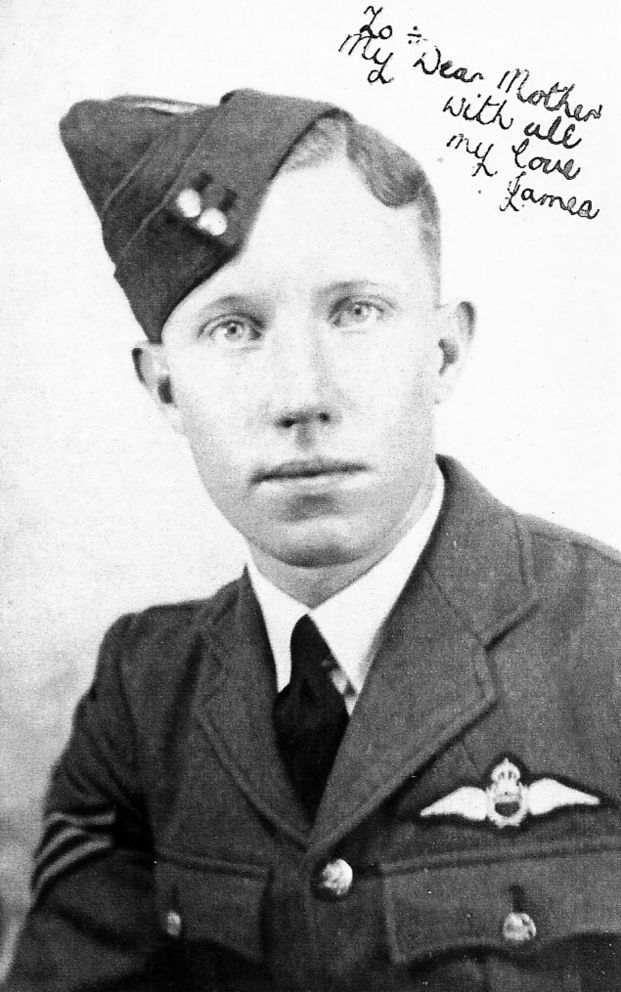
Lieutenant Thompson belonged to the Fighter Group "Rhodesia". Rhodesia at this time was an English colony, a part of the British Empire. It was divided into two regions, one was Northern Rhodesia (today Zambia), the other was Southern Rhodesia (now Zimbabwe). After the declaration of war against Germany on September 3rd, 1939, England launched all its forces into this new conflict. Groups of airmen from this region of South-East Africa quickly joined the RAF and participated in the Battle of Dunkirk, the Battle of Britain and many other fights, including later that of June 6th, 1944. The weather for this Monday, January 11th, 1943 looked good, a bit cool but with nice clearings. The combat group of Lieutenant Green was about to be informed of this mission. It was necessary to destroy quickly and efficiently, on this railway axis in Brittany, trains that were circulating by trageting first the locomotives easily spotted with their smoke. Traffic was intense on this line. It was delivering the fortress of Brest and its submarine base, but was also used for dispatching German forces throughout Brittany. Through these channels were transported men, ammunition, weapons, materials. All that the German occupier needed. The mission was not without risk, because Germans used to protect these railways by anti-aircraft defenses, the Flak. Some trains were even composed of wagons armed with efficient guns. At the briefing arrived the airmen who have been appointed to join the Leader of this mission. They were three, Lieutenant Deall, Lieutenant James Clack Thompson, nicknamed Tommy by his friends, and Lieutenant John Robert Dison Menelaws nicknamed Bob by friends. All these pilots were young but already confirmed their experience to fly the formidable Typhoon aircraft equipped with a huge engine, the '' Napier Sabre '' and armed with four 20mm Hispano-Suiza HS 404 guns as well as two bombs of 450 kg, one under each wing.
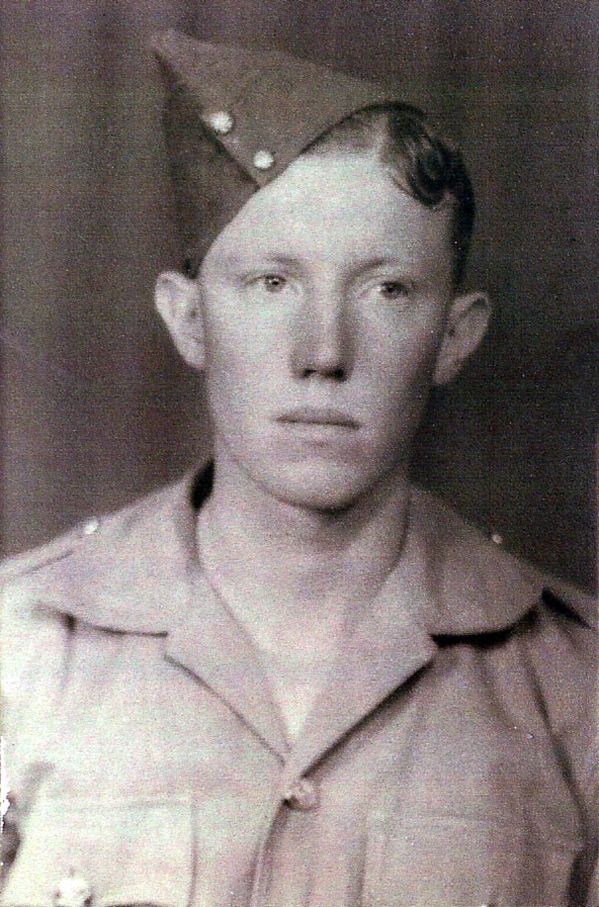
At about 8:45 am, the four aircrafts took off from Warmwell Airfield. The crossing of the English Channel went smoothly, at an average altitude. When approaching the Brittany coast, the leader warned his teammates and asked them to check their guns. They reduced thrust and started their descent when visualizing the target. The group flew over Etables-sur-Mer when suddenly Lieutenant Thompson by radio reported a problem. A cloud of smoke escaped from his engine, but also glycol used for cooling was leaking abundantly under the fuselage. The Typhoon was in trouble and very quickly it was unable to stay in flight. The leader ordered everyone to make a sharp turn to the east in order to leave the area that semt dangerous and from which an enemy shot was fired. Lieutenant Thompson was too low to jump and the aircraft was no longer able to recover altitude. He had only one solution left, to look as quickly as possible for a field where he would try and make a forced landing. It was 9:50 am when he mowed a row of oaks on an embankment near the village of the Auffray street in Plélo.
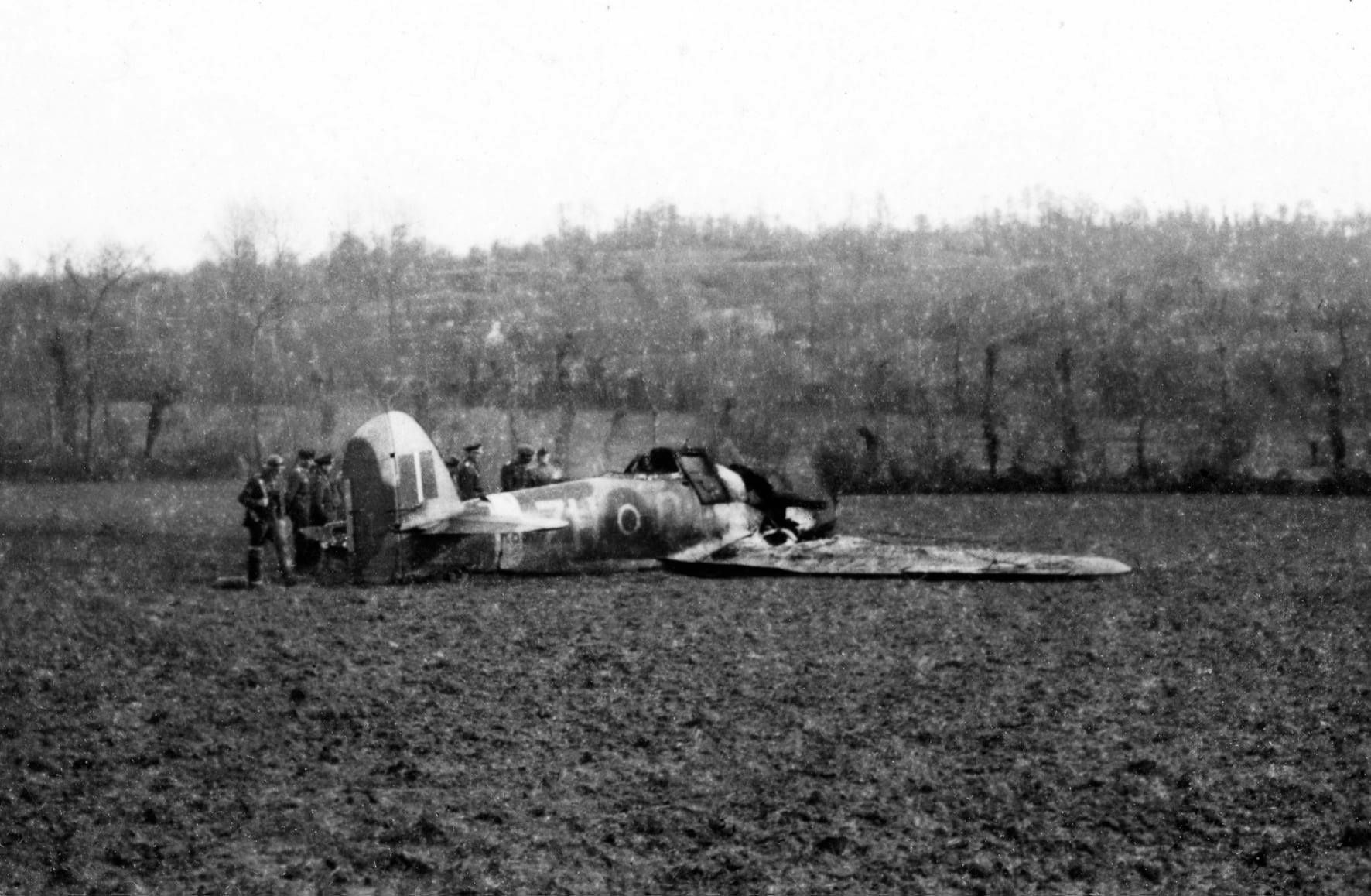
Le Typhoon after its belly landing in a field, surrounded by the Germans
Photo © collection L. Viton & L. Lemarchand

The field where the aircraft made a forced landing. In the background the hedge of trees on the embankment.
The Typhoon went through in the middle. The peaks form a V still visible today.
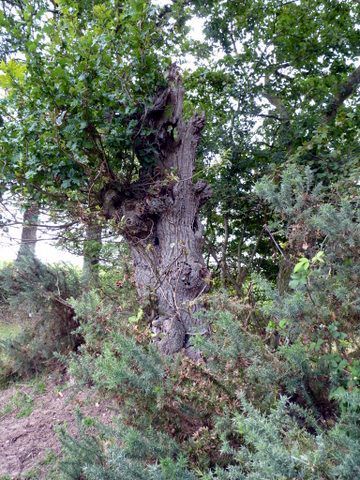
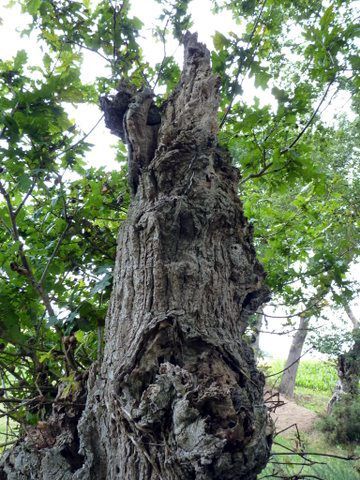
68 years after, the oak still shows the scars of Typhoon passage in the hedge
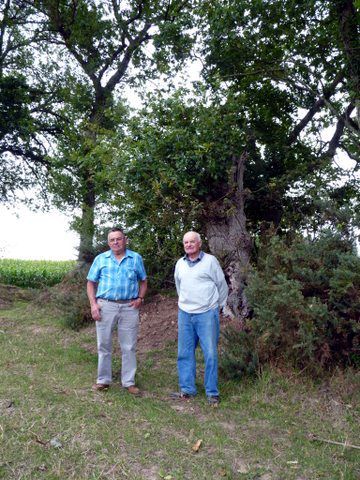
Mr Michel, Mr Pierre and Mr Paul guided us to the place of
the forced landing of Lt Thompson
The tough landing of the Typhoon was told in a testimony enclosed to this story. Mrs Prual, present the day of the crash, narrowly avoided the death. Lieutenant Thompson destroyed his Typhoon after this violent landing by burning it, so that the enemy could not recover it and analyze the equipment. The pilot was injured at the head and he was bleeding. After having received care in the nearby village, he ran and hided in another village. The Germans, having deployed several hundred men looking for him, captured him the same evening at 6.30 pm. His three teammates returned immediately to England after this event and established a missing report. After being sent to Stalag Luft 3 of Dulag, also known as Sagan, now in Poland, Lieutenant Thompson was sent in Germany at Stalag Luft 1, which was near the town of Barth on the Baltic Sea coast, north-west of Berlin.
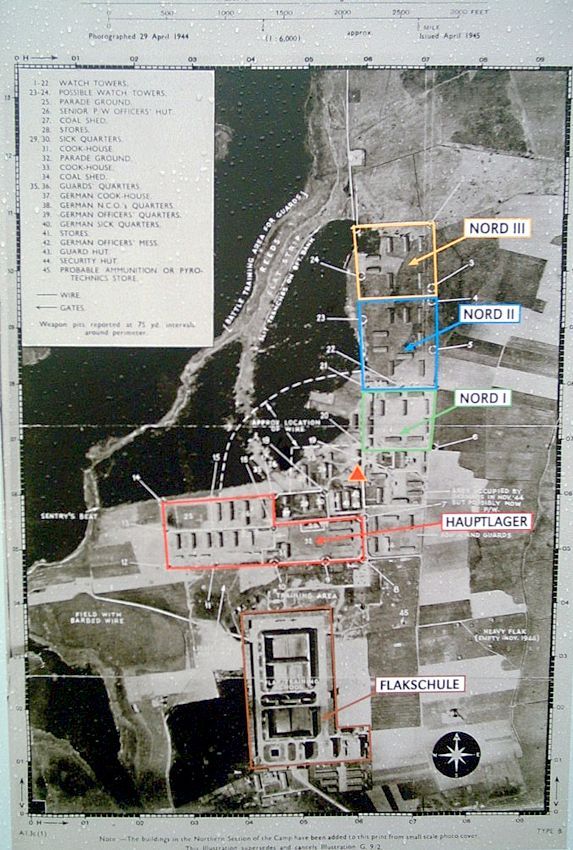
Photo of the plan of Stalag Luft 1 at Barth where Lt Thompson finished the war
Photo © Col. Joel Johnston

Road to the Stalag Luft 1 nowadays.
Photo © Col. Joel Johnston
The 3rd battery of the German artillery regiment 3/43 was stationed at that time in the city of Étables-sur-Mer. It was part of the Heer (Army). This regiment was equipped with a classic battery of FlaK 30, with 2 x 20 mm guns. Lieutenant Thompson was not lucky to be hit by these guns because the soldiers using these weapons were not experimented compared to the formidable anti-aircraft batteries of the Luftwaffe (German Air Force). A report indicated the position of this battery in the South-East of Étables-sur-Mer. It is true that at this time the Typhoons were flying at low altitude when preparing to attack.
Jean Michel Martin ABSA 39-45. 2nd September, 2011.
Thanks to Mrs Sylvie Prual, 92 years old, for her particularly accurate testimony and her kind welcome in her home in Plélo, as well as three witnesses, Mr Michel, Paul and Pierre who guided us on the spot, and finally to Mr Bruno Delmas who informed us about this event which was not listed in our region.
Thanks also to our friends of the association Gerfaut, Yannig Kerhousse, the President who did this research concerning Étables-sur-Mer as well as Michel Pieto and Pascal Meunier for their help.
PLÉLO. Côtes d'Armor, 11th January, 1943. Testimony of Mrs Sylvie Prual. Born Guéno. 92 years old.
"I remember very well this event that could have kill me. I was 23 years old and at this period of the year, we were busy cleaning the embankments along our fields. I was at this moment in a small path also called "Bonnette". It was war time and in the farms, often, men were missing. So we had to cope with all these difficult tasks. That morning I had a sickle and I arrived early in this little path that going along our field at the bottom of the village of Auffray Street. It was calm when suddenly I heard a terrible noise coming over me. I saw this aircraft at low altitude that flew in my direction, mowing a row of oaks in a terrible noise. The tree tops exploded. The aircraft arrived at high speed. It hit the ground in the field nearby, then bounced violently and laid on one side, and its wing struk the ground which made the aircraft turn on itself, throwing a lot of earth into the air. I was totally scared. Then it was a great silence. Everything had happened very quickly. I slowly approached this aircraft. I could clearly see the pilot in his cockpit. He did not move anymore. I was wondering about him. In the distance, my sister Louise, who was younger than me, and who stood at the doorstep at that moment, had seen everything and hastened to reach me. The marks on the aircraft made us realize that it was a friend. After a few minutes, the pilot started to move a little. This reassured us. Then he began to look around him. There was blood on his face. He opened the canopy and got off the aircraft quietly and slowly. While he was going around the wreck, he saw us. The word wreck was not too strong because the aircraft was seriously damaged. A torn open wing let us discover hundreds of tidy cartridges. He approached us very calmly. He was tall, blond with blue eyes. His temple was red with blood. He did not speak our language. He asked me to follow him. We both ran towards a shed where straw was stored. He motioned me to take a big load. He did the same and we quickly returned to the aircraft. He put his straw in the cabin and explained me by gestures to do the same, which I did. Then he set the straw on fire. Immediately the aircraft turned into a gigantic fire. The smoke rose high in the sky. The cartridges in the wings burst out with the action of fire, and it lasted a major part of the afternoon. Immediately after, he accompanied me at home. My grandmother Josephine Dudal hastened to clean his wound with a handkerchief soaked in "alcohol" (cider brandy). She poured him a little drop in glass. It saw warm milk in a saucepan. He asked if he could have some. He drunk a bowl, thanked and kissed my grandmother and then left at full speed. He slipped at the door, but caught himself in extremis, crossed the courtyard, ran along his aircraft and jumped over the embankment where the tops of the oaks were still on the ground. He disappeared into the neighboring fields. The Germans arrived in large numbers quickly and started searching all in the house and around it. They found nothing. They organized all around research in the neighboring villages. The pilot had found a refuge in a house in a nearby hamlet. The Germans found him in the evening. He was taken prisoner. The remains of his aircraft were recovered later. The task was difficult because of the muddy ground. It had been raining a lot these days. I can still see the horses pulling on the rails that the Germans have installed on the field, dragging it to the yard of our farm. This engine was loaded with great efforts on a truck. Nowadays no one can imagine what happened in this field at that time. Yes really, I could have died that day.
Testimony collected on September 1, 2011. Jean Michel Martin.
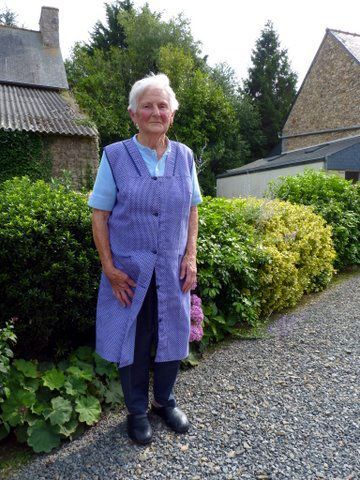
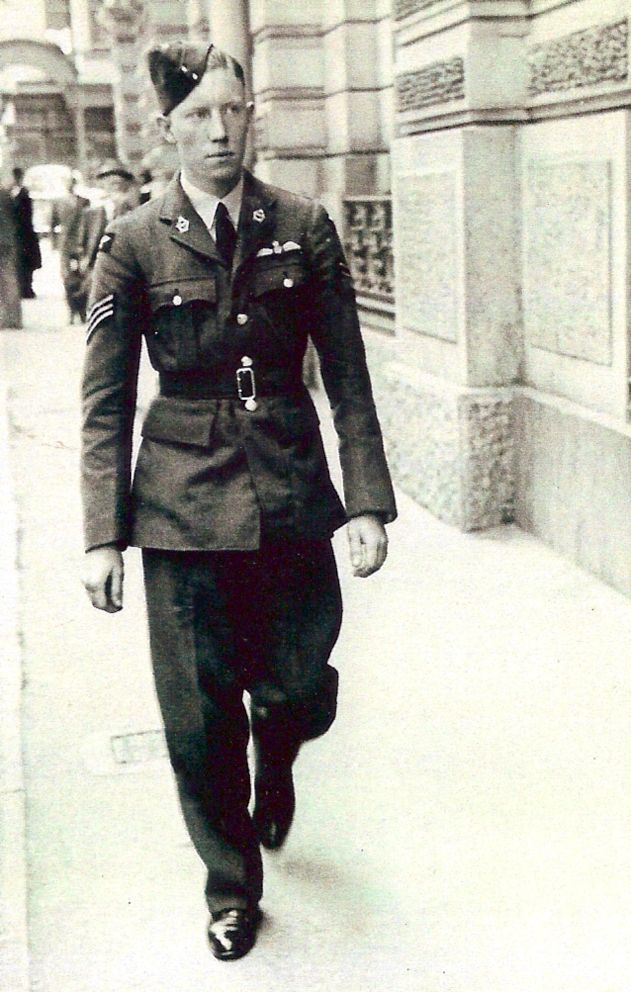
Mrs Sylvie Prual F/Lt James Clack THOMPSON
Bibliography : A Pride of Eagles:The Definitive History of the Rhodesian Air Force 1920-1980. Salt, Beryl. Weltevredenpark:Covos Day Books, 2001. pp.146-7 & 846.
Col BRUGGY. RafCommands Forums, 27th May, 2011.
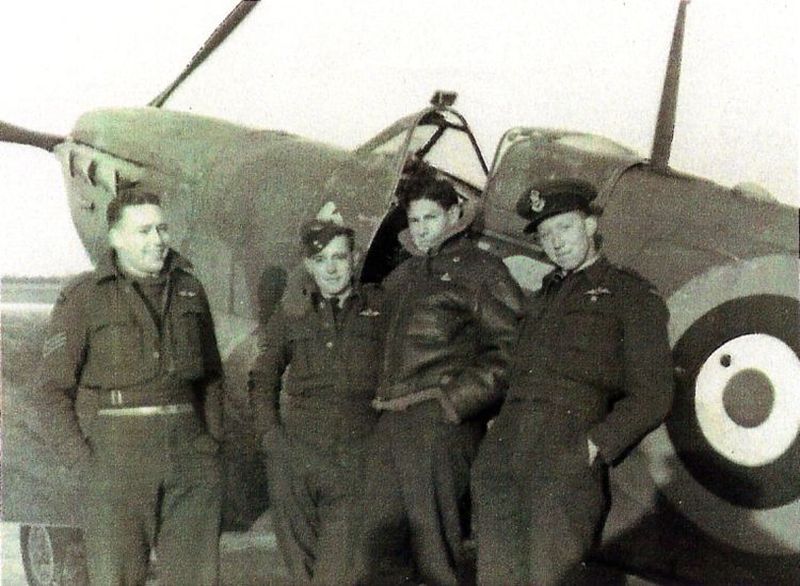
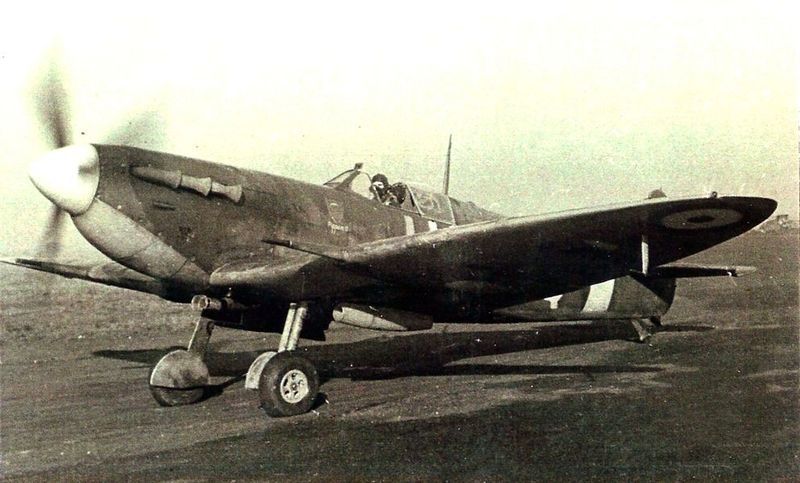
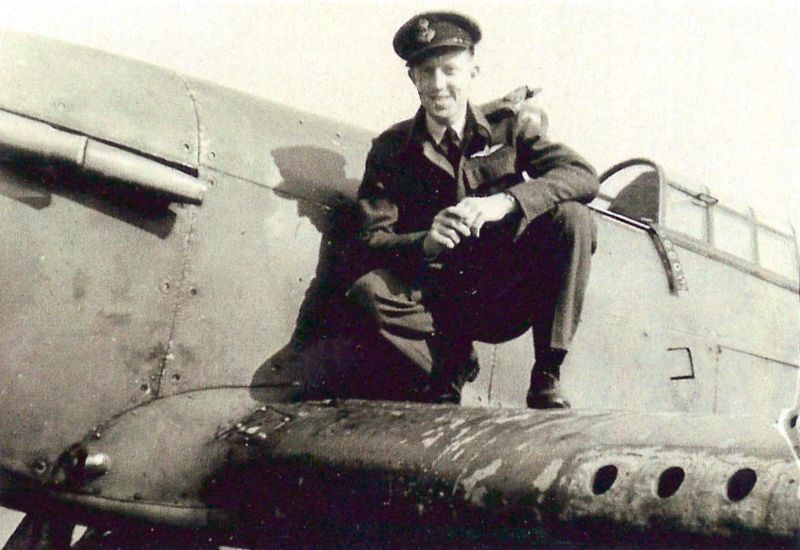
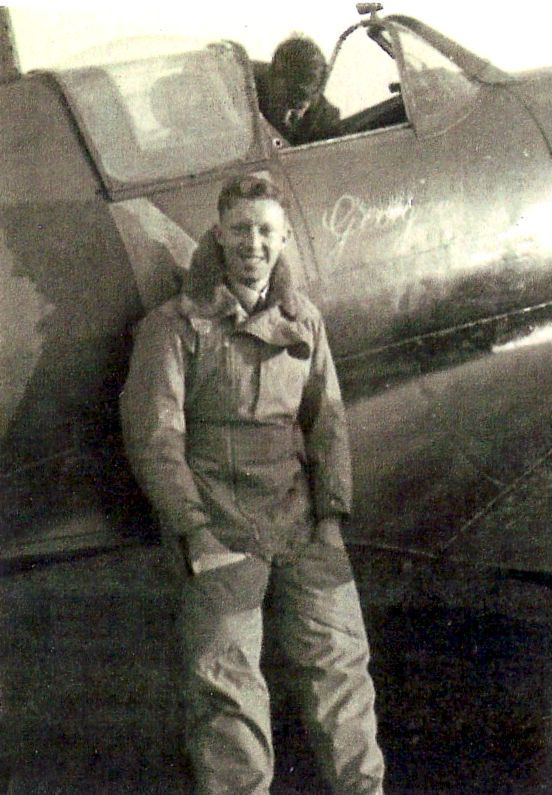
Story of my grandfather J.C. Thompson
INTRODUCTION
I decided to write my grandfather's story during World War II when I learned that he had been an aircraft pilot and flew on " Spitfires ". I wish to mention the difficulty of being a P.O.W.
When I used to speak with my grandfather, he was never aggressive or bitter towards the Germans. He was a very brave young man. He showed no fear and was proud to have fought for his country.
As he often told me, he flew for the spirit of adventure and not for the purpose of killing.
THE EARLY YEARS
My grandfather James Clak THOMPSON, was born in Rhodesia, now called Zimbabwe. He attended Milton School, which was a well-known public school in Bulawayo. He was seven when he saw his first plane and decided to become an aviator. He volunteered for the RAF in November 1939. It was then the beginning of the Second World War. Rhodesia was a member of the Commonwealth and many young men volunteered at that time. In his class, out of 30 students, only 3 returned from the war.
THE SQUADRON'S DUTY
His first job was on a " satellite airfield" in an old farm. His task was to operate raids between Holland and France (the Germans had invaded these two countries). The main responsibility of the 266 Squadron was to protect and escort the convoys of ships. These ships were traveling on the east coast of England. German aviation from Belgium tried and sink these ships. When ships were sunk, the Channel could have been blocked. The squadron also protected the Thames Estuary and operated patrols over East Anglia. The squadron have made many flights over France. They always flew in pairs during their mission. When they entered in the order of battle, there were always 12 aircrafts, 3 teams of 4. There was a squadron leader and two flight commanders. My grandfather was the commander on the left side, the left winger. He was in charge of controlling the radio between the aircrafts for their return to the base. When the squadron accompanied bombers over France, there were 3 squadrons to protect the foreigners (bombers of the United States). A squadron was flying over the bomber, one in front and the other behind. In that way, there were 36 fighters to protect a bomber. My grandfather was in many "dogfights" (it means close combat).
THE TYPHOONS AIRCRAFTS
In 1942, my grandfather was sent to Muxford, south of Cambridge, England. The Spitfire aircrafts joined the 609 Squadron and the UK 56. The Rhodesians were all together. The airmen were starting to fly on Typhoons which were combat aircrafts.
Many mistakes have been made with Spitfires that had a cruising speed of 530 km/h and a maximum speed of 600 km/h. They started to operate with the Typhoons but without success. During the first mission of the Canadians at Dieppe in France, 3 aircrafts were lost. My grandfather moved to Dorset and then to Warmwell in England. He often operated patrols from Southampton and the Isle of Wight aboard his Typhoon. See the attached press article "They put the Typhoon on the map ! "
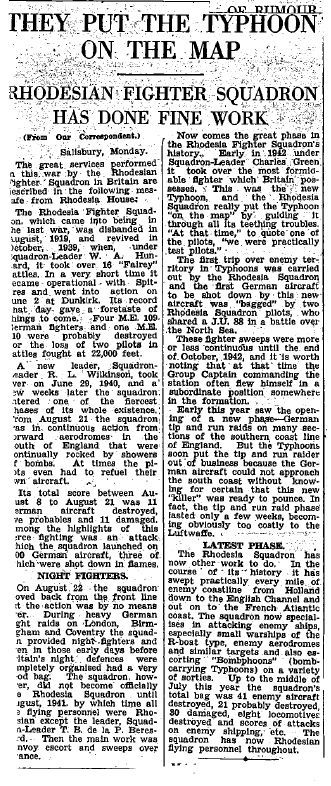
PRISONER
He was taken prisoner in Orly airport and placed in a room that was closed, he was alone. He tried to force the door with a nail taken from the bed. There was a German at the end of the hall listening to the news on the BBC radio. He surprised my grandfather and arrested him. My grandfather was transferred in a cell.
TRANSFER
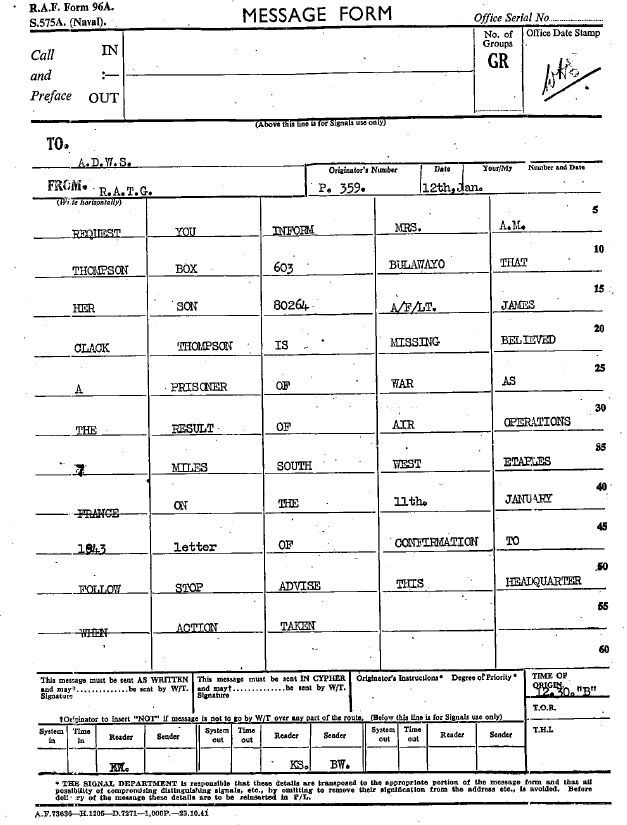
My grandfather, accompanied by a German Captain, was taken by train to Frankfurt in Germany. He was kept in total isolation. For breakfast, he had bread and a cup of coffee. For lunch, he was eating rotten potatoes and cabbage soup. For dinner, he had soup again and potatoes that he could steal. The Germans wanted to get military information from him. Once again, he was transferred to the Frankfurt camps.
See the enclosed message :
Form R.A.F. 96A S.575A (naval) on 12th January, 1943 at 10 am to authorities A.D.W.S. from R.A.T.G. Number P.359.
The request is : can you inform Mrs. A.M. THOMPSON - mailbox 603 at BULAWAYO that her son, Lieutenant James Clack Thompson, registration number 80264, of the Royal Air Force is missing. This is a prisoner of war following the result of air operations seven miles southwest of Etables in France on January 11, 1943. The letter of confirmation will follow. Inform the authorities if a decision is made. End of the recording at 12:30.
See enclosed letter : reference N°3000/312/1/P.3
To the authorities of the Rhodesian aviation training groups Mailbox 1379 at SALISBURY. May 11, 1943 addressed to Mrs. AM THOMPSON Highbury Hotel Main Road at BULAWAYO.
Madam,
A telegram was received by the High Commission for Southern Rhodesia informing us that your son Lieutenant JC THOMPSON, registration number 80264 in active flights, is a POW No. 175 and is now at Stalag Luft III in Germany. Signature: The Commander of the Air, commanding the Rhodesian Air Training Group.
See enclosed letter : reference N°3000/312/1/P.3
To the authorities of the Rhodesian aviation training groups Mailbox 1379 at SALISBURY. March 4, 1943 addressed to Mrs. AM THOMPSON Highbury Hotel Main Road at BULAWAYO.
Madam, In addition to my letter dated January 30, 1943, the following information has been received concerning your son. He is a prisoner of war at Stalag Dulag Luft in Germany. Signature : Vice Marshal of the Air, commanding the Rhodesian air training group.
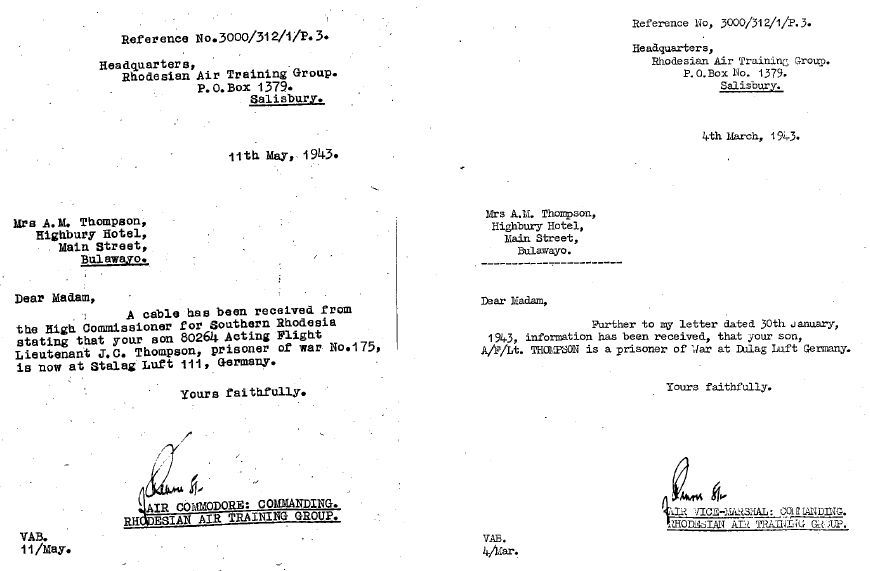
See enclosed newspaper article " Roll of honour " 30th January, 1943

LIVE IN A PRISONER OF WAR CAMP
JC THOMPSON has been a prisoner of war for 6 months. They were 4 to 8 people in each room. For breakfast, there was bread and parcels of the Red Cross. There was a mandatory call after each breakfast. No conversation possible with a German. Lunch consisted of bread, rotten potatoes, and fish, dinner was the same. They sometimes cooked their food with beef from the Red Cross. They had just enough calories to survive. They could just walk down the camp aisles.
During the winter they used to glide on snow. James still wore the uniform of R.A.F. There was great camaraderie between them and they shared the goods sent by the House of Rhodesia. Their only oxygen balloon was hope when they could listen to the radio. They had built one. They knew that the Germans were loosing and that the Russians were advancing towards them. They started sparing food from the Red Cross. It was snowing a lot and they built wooden chairs. They evacuated the camp at 2 o'clock one morning. Hitler wanted the prisoners of war to be taken to Berlin to prevent the British from dropping their bombs on the city. James and the other prisoners had to walk to Ckenwalde about 130 miles away
CLOSE TO DEATH
Once in Berlin, they were locked in cattle trucks and taken to Ckenwalde, south of Berlin. In this camp, there were also Russian prisoners who were starving. My grandfather and his comrades were dirty after traveling in these livestock. The Germans took the airmen into common showers that were actually gas chambers. It was only once inside that they realized where they were because there was no tap. But the gas was not sent. They were then taken to the barracks where the Russians were. They ate oatmeal and the worst food. After a few days, the English prisoners were taken to the center of Berlin in these same cattle trucks. There were many air battles at that time. English prisoners were pushed onto the roofs of the trucks to serve as human shields and deter the British from bombing the city. They were not killed. They returned to the camp. The Russians would soon arrive and release them. The Germans were well aware of it and disappeared from the camp overnight. They had released the Russian prisoners but took the others not far from the camp, this for one month while waiting for the continuation of the events.
THE LIBERATION
After the Russians, the Americans arrived with a huge convoy of trucks but the Russians did not want to let the prisoners go. Also, the prisoners returned to their camp to be identified. After another month, the decision was made : a Russian would be exchanged for an Ally. Americans fed them with chicken and ice cream that make them sick because they were not used to it. The Americans gave them clean clothes, but the prisoners wanted to go home above all. They were finally brought back to Brussels by aircraft. Three days later they returned to England and sent to Oxford. On the way back they almost crashed with a Lancaster bomber. James sends a telegram to Rhodesia, but he spent several months in England. He finally took the boat at Cape Town and then the train to Rhodesia. There was still rationing for gas and food.
See newspaper article with picture " These are all Rhodesians ".
Look at the second man from the right on the first row. It was the victorious march : thousands of citizens were in the streets yesterday when the contingents of South Africa and Rhodesia marched through Johannesburg for the parade of the English victory. The photo shows part of the contingent including the Rhodesians on Eloff Street.

THE VICTORY PARADE
My grandfather received an invitation for the victory parade from King George VI. He flew from Durban and it took him 6 days on a exhausting journey. There were 100 men from Rhodesia who walked. They belonged to the RAF, the Army and the Navy. My grandfather received a medal in memory of this parade.
See enclosed invitation

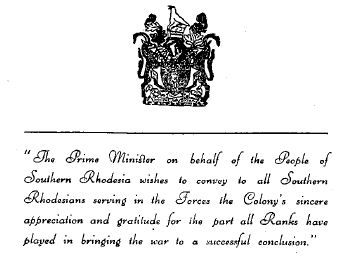
Thanks to Judith Boynton, daughter of Flight Lieutenant James Clack (Tommy) Thompson
Thanks to Keith from website : Conscript Heroes - keith@conscript-heroes.com
Testimony of Mr. Alain Galliot. Mayor of Penguily.
My mother Azeline Gaubert was born on May 22, 1917. During World War II she lived with her parents in the village of Trillac in Trémuson, Côtes du Nord at that time. In January 1943 she walked through a road located on the edge of the villages of Plélo and Trémuson, she discovered, on the edge of a ditch, a cap wearing a metal badge and two buttons, the badge marked RAF the British Air Army. She brought it back home, and showed it to his parents.
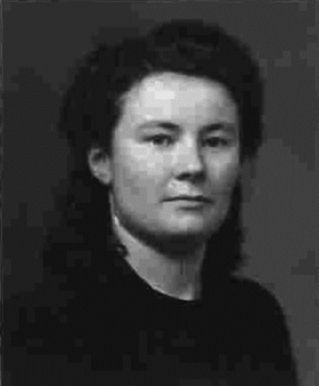
Mrs Azeline Gaubert
My grandfather asked her to remove this badge and the two buttons and then burn the cap in the fireplace. What she did immediately. My grandfather did not want to keep it because the Germans regularly came in the area and no compromising part had to be found in case of a search. The set was placed in a safe place in the family button box where they remained for more than 70 years. Mr Galliot found them at the beginning of 2015. Mr Jimmy Tual organized for me a meeting with Mr Galliot during a commemoration in Memory of the deportees in Trébry on May 1, 2015. For me it was obvious that this cap had belonged to the young pilot of Royal Air Force Captain James Clack Thompson whose Typhoon fighter plane had fallen into a field near the village of Auffray Street in Plélo on the edge of Trémuson on Monday, January 11, 1943. He lost his cap during his flight and was taken prisoner the same evening around 6:30 pm, numerous Germans being in search of him.
On Saturday, May 21, 2016 a commemoration in memory of Captain Thompson was organized in Plélo on the scene of the crash. His daughter Mrs Judith Boynton was present with relatives. She gave the uniform of her father to the city of Plélo. 72 years later, Mr Alain Galliot gave back the RAF badge and the two buttons to the family.
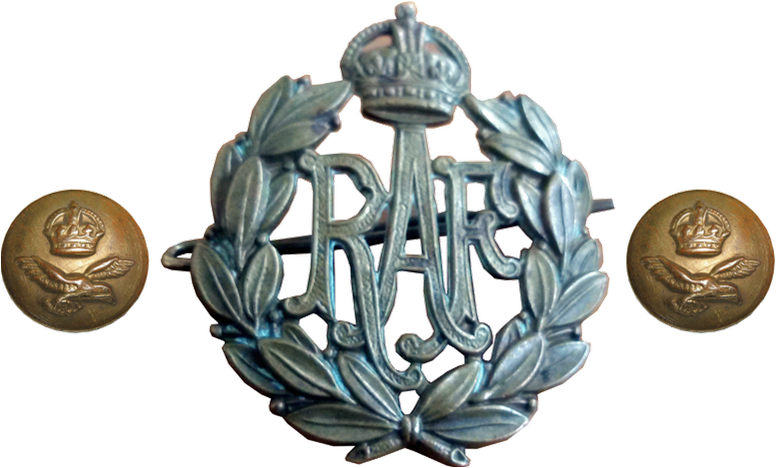
Thanks to Mister Alain Galliot and Mister Jimmy Tual, member of the "Association Bretonne du Souvenir Aérien 39 45" - AFMD 22 - Amis de la fondation pour la mémoire de la déportation en Côtes d'Armor.
Jean Michel Martin. October 2015
IN THE PRESS !
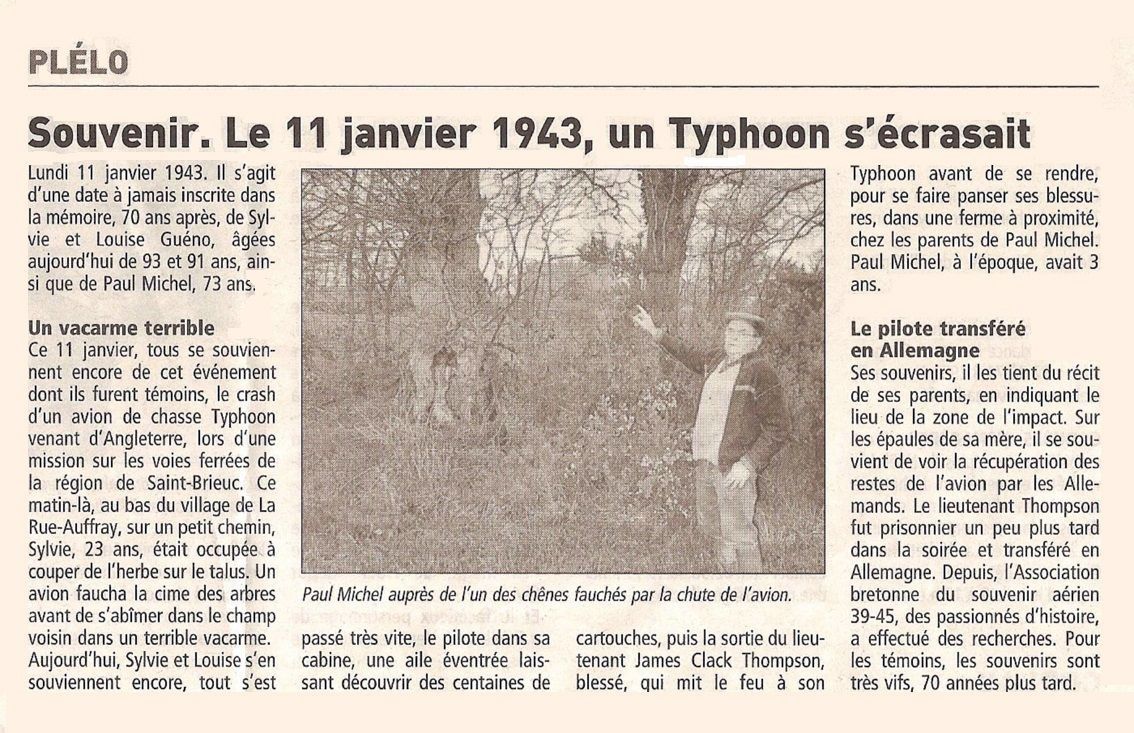
January 2013
Ajouter un commentaire

Commentaires
1 Ben van Drogenbroek Le 19/01/2023
James Clack Thompson is listed in my Stalag Luft 3 - East Compound - files (from the National Archives - England).
After The Forced March from Stalag Luft 3 at the end of January 1945, James Clack Thompson ended-up at Stalag III-A "Lückenwalde".
Best Regards,
Ben van Drogenbroek
- The Stalag Luft 3 Archives of Holland -
Stadhouderslaan 32
3417 TW Montfoort
The Netherlands